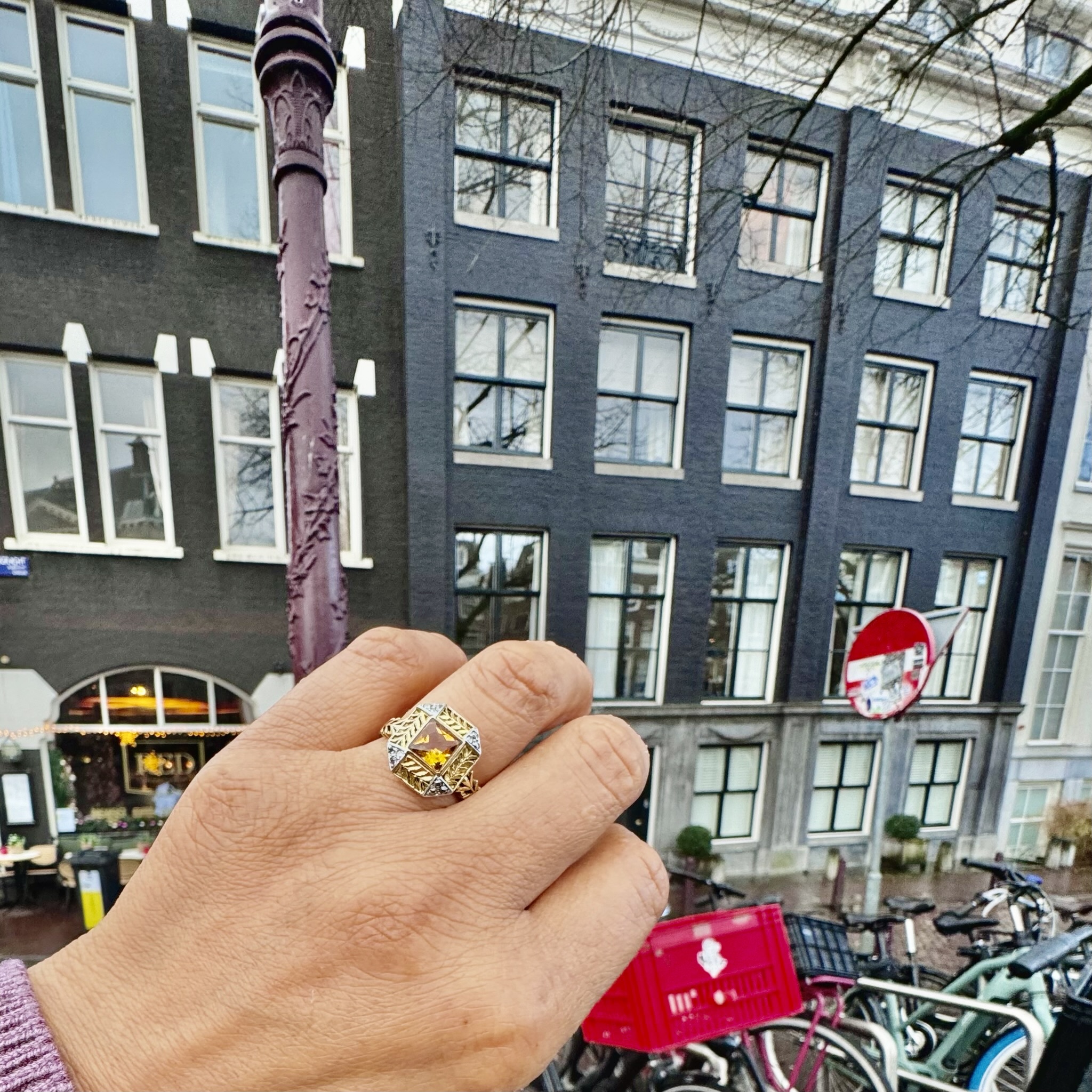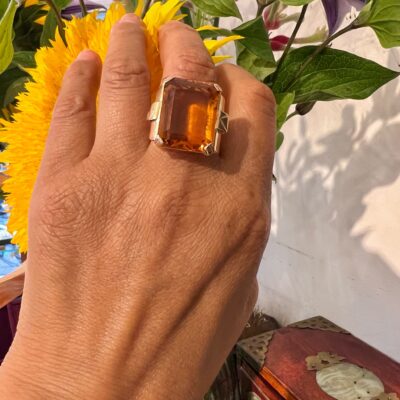This retro-era masterpiece (1935-1950) highlights a 1.25ct French-cut citrine, its golden-yellow hue glowing with brilliance. Framed by 12 old-mine-cut diamonds (I/J SI1/SI2) totaling approx. 0.15ct, the ring features intricate 18k yellow gold openwork and leaf motifs. White gold accents enhance the sparkle, while the bold geometric design adds a timeless elegance that defines the retro aesthetic. French hallmark.
Videos
Details: ±1.25ct Citrine, 12 totaling ±0,15ct (I/J SI1/SI2) Old-mine-cut diamonds, 18k Ring, French hallmark.
Design Era: Retro (1935-1950).
Size: 17.93 NL / 56.3 FR / 7¾ US / P UK, sizeable (Within reason. Contact seller for information).
Weight in grams: 4.3.
Condition: Excellent condition – barely used with minimal signs of wear.
Shipping and Pickup: This elegant piece ships from our store located in the center of Amsterdam, The Netherlands. We offer both registered shipping and local pickup at our store. In the case of local pickup, any applicable shipping costs will be refunded.
About Us: Add some sparkle to your style with Binenbaum.com. We offer a stunning selection of antique and vintage jewelry that you won’t find anywhere else. From timeless rings and dazzling necklaces to unique brooches, we have something for every taste and occasion. Visit our website today and treat yourself to a piece of history.
| Design Era | |
|---|---|
| Design & Historical Context | The jewelry industry was significantly impacted by the onset of World War II in the 1940s. Precious metals, particularly platinum, became scarce and in some cases were even banned from being sold. Palladium was used as a substitute for platinum in the war effort. In order to make the most of the limited supply of gold, a low karat gold alloy with a higher percentage of copper was used. This resulted in gold with a subtle, reddish hue, but through the use of different alloys, gold was able to appear in a range of colors within a single piece. Gold was also manipulated in various ways, such as being woven, braided, and coiled. Techniques like resilla, cannetille, and lacy filigree patterns reappeared in jewelry. Different textures were also used within a single design, with matte finishes being placed next to bright finishes to accentuate the design. Gold became the primary metal used in jewelry during the 1940s and 1950s. |
| Key Materials | |
| Materials & Craftsmanship | Citrine: The Gem of Joy and Abundance Citrine, with its warm, golden hues, is a gemstone that radiates positivity, joy, and abundance. This captivating gem is a variety of quartz, with colors ranging from pale yellow to deep amber, often reminiscent of the sun's warm glow. Its vibrant color comes from trace amounts of iron within the crystal structure. Historically, citrine has been treasured for its beauty and believed to carry the energy of the sun, bringing warmth, vitality, and happiness to those who wear it. In ancient times, citrine was known as the merchant’s stone, believed to attract wealth and prosperity. It was also used as a protective talisman against negative energies and was thought to inspire confidence and clarity in decision-making. In modern jewelry, citrine is cherished for its brilliance and affordability. With a Mohs hardness of 7, it is durable enough for everyday wear, making it a popular choice for rings, necklaces, earrings, and bracelets. Citrine's sunny disposition pairs well with both gold and silver, adding a touch of warmth and light to any jewelry design. Citrine is more than just a gemstone; it is a symbol of joy, success, and positive energy. Its radiant color and uplifting qualities make it a beloved choice for jewelry that celebrates life’s bright moments and encourages an optimistic outlook. Old-mine-cut diamond: The Vintage Gem of Nostalgia and Charm The Old Mine-cut diamond is a captivating choice for those who appreciate the charm and character of vintage jewelry. Known for its distinctively antique look, this cut dates back to the 18th century and was the precursor to the modern brilliant cut. Old Mine-cut diamonds are characterized by their slightly cushion-like shape, high crown, small table, deep pavilion, and large, open culet, all of which contribute to their unique and romantic appeal. Historically, the Old Mine cut was the most popular diamond cut during the Georgian and Victorian eras. These diamonds were cut by hand, long before the advent of modern cutting technology, which means each stone has its own unique proportions and personality. The cut was designed to maximize the diamond’s brilliance under candlelight, giving it a warm, glowing sparkle that has captivated jewelry lovers for centuries. In modern times, Old Mine-cut diamonds are cherished for their vintage elegance and historical significance. Their distinctive appearance, with a smaller table and larger facets, produces a softer, more subdued brilliance compared to modern cuts, which adds to their old-world charm. These diamonds are often found in antique and heirloom jewelry, such as engagement rings, brooches, and pendants, where their timeless beauty can be fully appreciated. An Old Mine-cut diamond is more than just a gemstone; it is a piece of history, reflecting the craftsmanship and artistry of a bygone era. Its nostalgic appeal and unique sparkle make it a perfect choice for those who seek a diamond that tells a story and exudes vintage elegance and charm. 18k: The Perfect Balance of Luxury and Durability 18k gold is a luxurious and highly sought-after material in the world of fine jewelry, known for its rich color, durability, and value. The 18k refers to the purity of the gold, indicating that it is composed of 75% pure gold and 25% alloyed metals, such as copper, silver, or palladium. This combination provides the perfect balance between the softness of pure gold and the strength needed for creating durable jewelry. Historically, gold has been prized for its beauty and rarity, symbolizing wealth, power, and status across various cultures and civilizations. 18k gold has been a preferred choice in fine jewelry for centuries due to its ideal blend of purity and strength, offering a radiant gold color that is more vibrant than lower karat golds while still being hard enough for everyday wear. In modern jewelry, 18k gold is favored for its versatility and its ability to enhance the appearance of gemstones. It is available in several colors, including yellow, white, and rose gold, depending on the metals used in the alloy. Each color has its unique appeal: Yellow Gold: The classic choice, offering a warm, rich hue that pairs beautifully with a wide range of gemstones and complements all skin tones. White Gold: A sleek, modern option that resembles platinum or silver but with the strength and luxury of gold. It is often rhodium-plated to enhance its reflective surface. Rose Gold: A romantic, pinkish hue that has gained popularity for its vintage charm and contemporary appeal, achieved by alloying gold with copper. 18k gold is commonly used in engagement rings, wedding bands, earrings, necklaces, and bracelets, where its balance of durability and beauty makes it ideal for both intricate designs and simple, elegant pieces. The alloy's added strength ensures that jewelry can withstand daily wear while maintaining its luster and shape. 18k gold is more than just a material; it is a symbol of refined taste and enduring value. Its perfect blend of luxury and practicality makes 18k gold a timeless choice for those who seek the beauty of high-purity gold without sacrificing durability. Whether in classic or modern designs, 18k gold jewelry offers a radiant and lasting expression of elegance and sophistication. |
| Size | |
| Gender | |
| Weight (in grams) | 4.3 |
| Condition | Excellent condition – barely used with minimal signs of wear |
By following these tips, you can enjoy your precious jewelry for many years to come.
Related Products
-
Diamond 18k Retro Ring 7175-0156
€ 3.895,00 VAT incl. (where applicable) -
Citrine Diamond 14k Platinum Cluster Ring 8612-2089
€ 3.495,00 VAT incl. (where applicable) -
Citrine Diamond 14k Cocktail Ring 13296-8128
€ 2.895,00 VAT incl. (where applicable) -
Citrine Diamond 14k Solitaire Ring 13156-5052
€ 2.295,00Original price was: € 2.295,00.€ 1.995,00Current price is: € 1.995,00. VAT incl. (where applicable) -
Citrine 14k Vintage Ring 14256-2422
€ 4.695,00 VAT incl. (where applicable) -
Diamond 18k Platinum Ring 14401-2411
€ 2.895,00 VAT incl. (where applicable) -
Diamond 18k Trilogy Ring 17323-9173
€ 2.495,00 VAT incl. (where applicable) -
Diamond Spinel 18k Tank Ring 17289-9145
€ 2.895,00 VAT incl. (where applicable)
- Home
- Collection
- Fine Jewelry
- Silver Jewelry
- Silverware
- Boxes
- Candlesticks
- Salt and pepper shakers
- Miniatures
- Salt cellars
- Spoon Set
- Condiments
- Frames
- Napkin Ring
- Spoon
- Oddities
- Cups
- Vases
- Cutlery
- Serving Spoon And Cake Server
- Candlesticks
- Baskets
- Hanukkiah
- Spice Tower
- Yad
- Tea Set
- Sugar Castor
- Napkin Rings
- Wine Bottle Coaster
- Wine Stopper
- Tea Pot
- Jugs
- Rattles
- Hip Flask
- Miscellaneous
- Rings 💍
- About
- Contact
- No products in the cart.

























